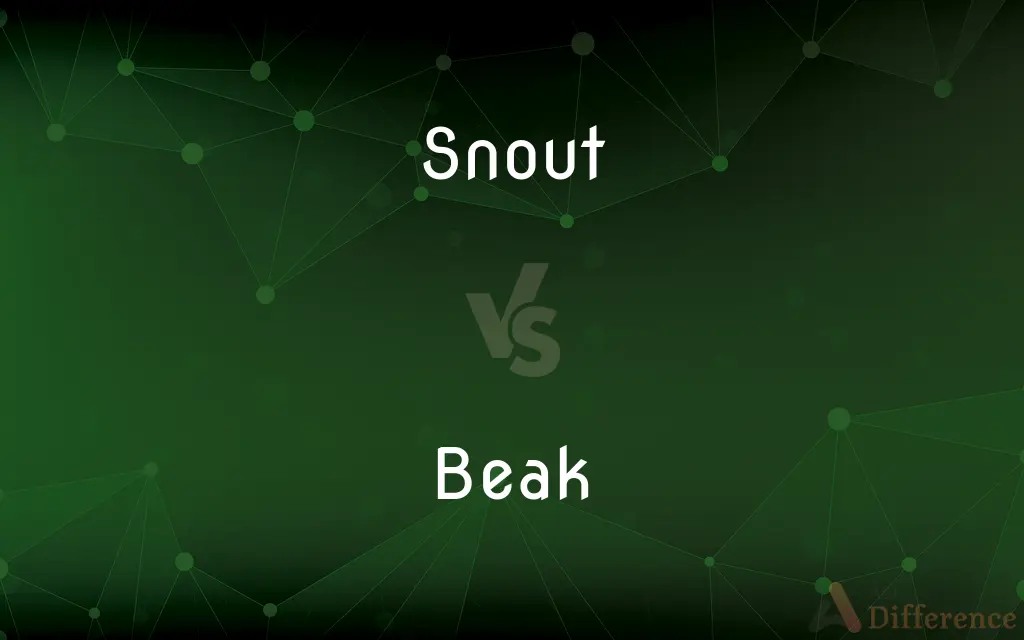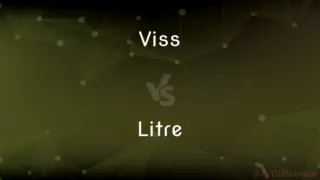Snout vs. Beak — What's the Difference?
Edited by Tayyaba Rehman — By Urooj Arif — Updated on April 25, 2024
Snouts are generally fleshy nose extensions in mammals, aiding in breathing and smelling, while beaks, found in birds and some reptiles, are hard and keratinous, serving mainly for feeding.

Difference Between Snout and Beak
Table of Contents
ADVERTISEMENT
Key Differences
A snout is the protruding part of the face in many mammals, including dogs and pigs, mainly used for breathing and smelling. Whereas, a beak refers to the hard, pointed external structure of the mouths of birds, serving as a tool for feeding, grooming, and manipulation of objects.
Snouts are typically soft and fleshy with a sense of touch and numerous sensory receptors. On the other hand, beaks are hard and lack sensory receptors but are very strong and adapted to a bird’s dietary needs.
In terms of shape and functionality, snouts vary widely among different species and are often suited to the animal's environment and feeding habits. Conversely, beaks also show great variation in shape and size, directly reflecting the feeding ecology and niche of the bird.
The snout houses important organs like the mouth and nostrils and plays a crucial role in an animal's sense of smell. In contrast, the beak acts not only as a feeding tool but also often replaces the role of hands in birds, used for a multitude of tasks including grooming and building nests.
Snouts and beaks represent different adaptations to environmental challenges; the snout evolved primarily for enhanced olfactory senses and feeding practices in mammals, whereas the beak is a versatile adaptation among birds for feeding, defense, and other uses.
ADVERTISEMENT
Comparison Chart
Composition
Soft, fleshy
Hard, keratinous
Primary Function
Breathing, smelling
Feeding, grooming, manipulation
Sensory Capabilities
High sensory receptors
Lacks sensory receptors
Variability
Highly variable among species
Highly variable among species
Evolutionary Purpose
Enhanced olfactory senses
Versatility in usage and diet adaptation
Compare with Definitions
Snout
An extended part of the face in certain animals, especially mammals.
The elephant used its snout to pick up objects.
Beak
A rigid external mouthpart in birds that lacks teeth.
The toucan's colorful beak is one of its most striking features.
Snout
A projecting nose or mouth of an animal.
The dog sniffed the air with its snout.
Beak
A keratinous part of a bird’s head used for feeding, fighting, and grooming.
The woodpecker pecked at the tree with its beak.
Snout
The anterior projecting part of the head of an animal with jaws.
The anteater’s snout is perfectly shaped for accessing termites in narrow holes.
Beak
A bird's horny projecting jaws.
The parrot cracked nuts with its strong beak.
Snout
The part of an animal's head projecting forward and containing the nose and jaws.
The pig dug into the ground with its snout.
Beak
A pointed, mouthlike structure of birds, used for eating and for grasping things.
The eagle swooped down to catch the fish with its sharp beak.
Snout
The nose of an animal regarded as a tool for sniffing or smelling.
The raccoon used its snout to root through the garbage.
Beak
The upper and lower parts of birds' mouths that function as tools for various behaviors.
The heron used its beak to skim small fish from the water.
Snout
A snout is the protruding portion of an animal's face, consisting of its nose, mouth, and jaw. In many animals, the structure is called a muzzle, rostrum, or proboscis.
Beak
The beak, bill, and/or rostrum is an external anatomical structure found mostly in birds, but also in non-avian dinosaurs and some mammals. A beak is used for eating and for preening, manipulating objects, killing prey, fighting, probing for food, courtship and feeding young.
Snout
The projecting nose, jaws, or anterior facial part of an animal's head.
Beak
A bird's horny projecting jaws; a bill
A parent bird with a caterpillar in its beak
Snout
A similar prolongation of the anterior portion of the head in certain insects, such as weevils; a rostrum.
Beak
A magistrate or a schoolmaster.
Snout
A spout or nozzle shaped like such a projection.
Beak
The bill of a bird, especially one that is strong and curved, such as that of a hawk or a finch.
Snout
(Slang) The human nose.
Beak
A similar structure in other animals, such as turtles, insects, or fish.
Snout
The long, projecting nose, mouth, and jaw of a beast, as of pigs.
The pig rooted around in the dirt with its snout.
Beak
A usually firm, tapering tip on certain plant structures, such as some seeds and fruits.
Snout
The front of the prow of a ship or boat.
Beak
The spout of a pitcher.
Snout
(derogatory) A person's nose.
His glasses kept slipping further down onto his prominent snout.
Beak
A metal or metal-clad ram projecting from the bow of an ancient warship.
Snout
The nozzle of a pipe, hose, etc.
If you place the snout right into the bucket, it won't spray as much.
Beak
(Informal)The human nose.
Snout
The anterior prolongation of the head of a gastropod; a rostrum.
Beak
A schoolmaster.
Snout
The anterior prolongation of the head of weevils and allied beetles; a rostrum.
Beak
A judge.
Snout
Tobacco; cigarettes.
Beak
Anatomical uses.
Snout
The terminus of a glacier.
Beak
A rigid structure projecting from the front of a bird's face, used for pecking, grooming, foraging, carrying items, eating food, etc.
Snout
(slang) A police informer.
Beak
A similar structure forming the jaws of a turtle, platypus, etc.
Snout
A butterfly in the nymphalid subfamily Libytheinae, notable for the snout-like elongation on their heads.
Beak
The long projecting sucking mouth of some insects and other invertebrates, as in the Hemiptera.
Snout
To furnish with a nozzle or point.
Beak
The upper or projecting part of the shell, near the hinge of a bivalve.
Snout
The long, projecting nose of a beast, as of swine.
Beak
The prolongation of certain univalve shells containing the canal.
Snout
The nose of a man; - in contempt.
Beak
(botany) Any process somewhat like the beak of a bird, terminating the fruit or other parts of a plant.
Snout
The nozzle of a pipe, hose, etc.
Beak
Figurative uses.
Snout
The anterior prolongation of the head of a gastropod; - called also rostrum.
Beak
Anything projecting or ending in a point like a beak, such as a promontory of land.
Snout
To furnish with a nozzle or point.
Beak
(architecture) A continuous slight projection ending in an arris or narrow fillet; that part of a drip from which the water is thrown off.
Snout
A long projecting or anterior elongation of an animal's head; especially the nose
Beak
(farriery) A toe clip.
Snout
Informal terms for the nose
Beak
(nautical) That part of a ship, before the forecastle, which is fastened to the stem, and supported by the main knee.
Snout
Beaklike projection of the anterior part of the head of certain insects such as e.g. weevils
Beak
(nautical) A beam, shod or armed at the end with a metal head or point, and projecting from the prow of an ancient galley, used as a ram to pierce the vessel of an enemy; a beakhead.
Beak
(entomology) Any of various nymphalid butterflies of the genus Libythea, notable for the beak-like elongation on their heads.
Beak
Colloquial uses.
Beak
(slang) The human nose, especially one that is large and pointed.
Beak
Cocaine.
Beak
A justice of the peace; a magistrate.
Beak
A schoolmaster (originally, at Eton).
Beak
(transitive) Strike with the beak.
Beak
(transitive) Seize with the beak.
Beak
To play truant.
Beak
The bill or nib of a bird, consisting of a horny sheath, covering the jaws. The form varies much according to the food and habits of the bird, and is largely used in the classification of birds.
Beak
Anything projecting or ending in a point, like a beak, as a promontory of land.
Beak
A beam, shod or armed at the end with a metal head or point, and projecting from the prow of an ancient galley, in order to pierce the vessel of an enemy; a beakhead.
Beak
That part of a ship, before the forecastle, which is fastened to the stem, and supported by the main knee.
Beak
A continuous slight projection ending in an arris or narrow fillet; that part of a drip from which the water is thrown off.
Beak
Any process somewhat like the beak of a bird, terminating the fruit or other parts of a plant.
Beak
A magistrate or policeman.
Beak
Beaklike mouth of animals other than birds (e.g., turtles)
Beak
Horny projecting mouth of a bird
Beak
Informal terms for the nose
Beak
Hit lightly with a picking motion
Common Curiosities
How do snouts and beaks differ in terms of evolution?
Snouts have evolved to enhance olfactory senses in mammals, while beaks are an adaptation in birds for a variety of tasks beyond just feeding.
Do all birds have the same type of beak?
No, beaks vary greatly among birds, typically according to their diet and environment.
How does the structure of a beak relate to a bird's habitat?
A bird's beak shape often correlates with its habitat and feeding strategy, such as long, thin beaks for probing flowers or strong, hooked beaks for tearing meat.
Are there any birds that do not have beaks?
All birds have some form of a beak, though the size, shape, and strength vary widely among species.
What are the main functions of a snout?
Mainly for breathing, smelling, and occasionally for manipulating objects.
What are the main functions of a beak?
Primarily for feeding, but also for grooming, manipulating objects, and sometimes for defense.
Can the shape of a snout tell something about an animal’s diet?
Yes, the shape and size of a snout can indicate an animal’s primary diet and feeding habits.
Can the functionality of a snout compare to that of a beak in any way?
While both structures assist in feeding, a snout usually provides added sensory functions such as smelling, which beaks do not offer, making them fundamentally different in their roles.
Is a snout present in all mammals?
Not all mammals have prominent snouts; primates, for example, have flatter faces with less pronounced snouts.
What role does the snout play in an animal's sensory perception?
The snout is crucial for tactile and olfactory sensory perception, allowing animals to smell and touch, thereby understanding their environment better.
Share Your Discovery

Previous Comparison
Viss vs. Litre
Next Comparison
Festival vs. HolidayAuthor Spotlight
Written by
Urooj ArifUrooj is a skilled content writer at Ask Difference, known for her exceptional ability to simplify complex topics into engaging and informative content. With a passion for research and a flair for clear, concise writing, she consistently delivers articles that resonate with our diverse audience.
Edited by
Tayyaba RehmanTayyaba Rehman is a distinguished writer, currently serving as a primary contributor to askdifference.com. As a researcher in semantics and etymology, Tayyaba's passion for the complexity of languages and their distinctions has found a perfect home on the platform. Tayyaba delves into the intricacies of language, distinguishing between commonly confused words and phrases, thereby providing clarity for readers worldwide.
















































